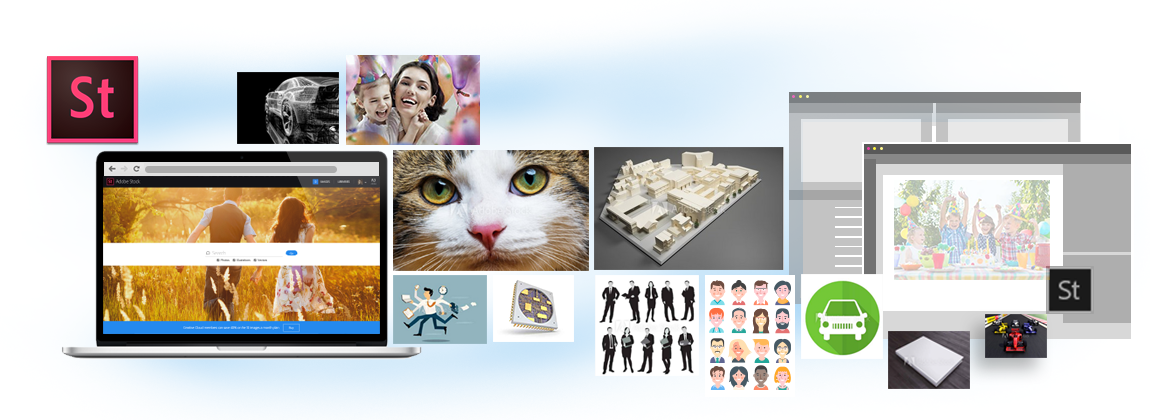Adobe Stock is a treasure trove of high-quality stock images, videos, templates, and 3D assets designed to enhance creative projects. Integrated seamlessly with Adobe Creative Cloud applications, it provides designers, marketers, and content creators with easy access to millions of assets. Whether you're working on a marketing campaign, web design, or social media content, Adobe Stock offers a robust library to elevate your visuals.
What sets Adobe Stock apart is not only its vast collection but also its user-friendly interface that facilitates quick searches and smooth downloads. You can filter results based on various criteria like image type, orientation, and color, making it straightforward to find the exact asset you need. This platform is not just about images; it also offers videos, templates, and even 3D models for those looking to take their projects to the next level.
Types of Licenses Offered by Adobe Stock

When you dive into Adobe Stock, you'll encounter a few licensing options that cater to different needs. Understanding these licenses is crucial to ensure that you comply with copyright regulations while making the most of your subscription. Here's a breakdown of the main types of licenses:
- Standard License: Perfect for most personal and commercial projects, this license allows you to use images in various mediums, including websites, social media, and print. However, it has some limitations. For instance, you can't use the images for resale or as a standalone item.
- Enhanced License: If you’re looking for more flexibility, the enhanced license is your go-to. This option grants you permission to use images in larger formats, like merchandise or in products that are intended for resale. It also covers greater distribution and allows for more extensive use, so if your project has higher stakes, consider this option.
Here’s a quick table summarizing the key differences:
| License Type | Usage Type | Resale Rights |
|---|---|---|
| Standard License | Personal & Commercial Use | No |
| Enhanced License | Commercial Use, including Merchandise | Yes |
So, whether you're a small business owner or a professional designer, knowing the ins and outs of Adobe Stock licensing can help you maximize your creativity while staying on the right side of copyright laws.
Also Read This: A Comprehensive Guide to Flipping Videos for Dailymotion Content
3. Standard License Explained

When diving into the world of Adobe Stock, one of the first things you'll encounter is the Standard License. This license is designed for creative projects ranging from personal endeavors to small-scale commercial use. So, what exactly does it cover?
- Usage Limitations: The Standard License allows you to use Adobe Stock images in various projects, such as websites, blogs, social media posts, and printed materials. However, it does not permit the use of the images for items intended for resale or distribution, like merchandise or templates.
- Quantity Restrictions: Generally, you can use the licensed content in projects that will be viewed up to 500,000 times. If your project exceeds this limit, you may need to explore other licensing options.
- Media Effects: This license is perfect for digital and print media, giving you flexibility in how you showcase your creativity. From brochures to ad campaigns, the Standard License covers it all.
For instance, imagine you're designing an engaging flyer for a local event. With the Standard License, you can download and utilize beautiful stock photos that enhance the visual appeal of your project. However, if you plan to sell that flyer as a template, you’ll need to consider upgrading to an Extended License.
In summary, the Standard License is a great option for creators who want to incorporate high-quality images into their work without breaking the bank. Just remember the usage restrictions, and you'll be on your way to making amazing projects with Adobe Stock!
Also Read This: Top Benefits of Using Imago Images for Your Business Visuals
4. Extended License Explained

Now, let's talk about the Extended License. This license is like the golden ticket for anyone looking to take their projects to the next level. While the Standard License covers a broad range of uses, the Extended License opens doors to more commercial and lucrative opportunities.
- No Limits on Distribution: With an Extended License, you can use Adobe Stock content in projects that are intended for resale or distribution. Whether you're creating products like mugs, T-shirts, or any other merchandise, this license has got you covered.
- Higher Viewership Allowance: The Extended License also allows for unlimited viewership. So whether your project will be seen by thousands or millions, you won't have to worry about hitting a ceiling.
- Modification Freedom: You can alter and manipulate the content without restrictions, which is particularly useful for designers who want to create unique products.
Consider this scenario: You've designed a fabulous line of greeting cards featuring beautiful stock images from Adobe Stock. With the Extended License, you can sell those cards online without worrying about licensing issues. It’s a win-win!
In summary, the Extended License is your best bet if you plan to monetize your project through resale, or if you're looking for more flexibility in distribution and modifications. Just like the Standard License, it provides you access to incredible content, but with that extra layer of freedom you need for commercial ventures!
Also Read This: Why YouTube Darkens My Videos
5. Usage Rights and Restrictions
When diving into the world of Adobe Stock, it’s crucial to understand the various usage rights and restrictions associated with the assets you want to use. This helps ensure that you’re not only getting the most out of the service but also using content in a way that respects the original creator's rights.
Adobe Stock offers two main types of licenses: *Standard License and Extended License*. Let’s break these down:
- Standard License: This is perfect for most personal and commercial projects and covers a wide range of uses. However, it has some limitations:
- Can be used in marketing materials, social media, and websites.
- Not allowed for merchandise or on products for resale.
- Resale of modified versions is also not permitted.
- Extended License: If your project requires more flexibility, the extended license is your go-to option. Here’s what it allows:
- Use in physical merchandise like t-shirts, mugs, and prints.
- Can be included in templates for sale.
- Higher limits on the number of copies made or distributed.
Additionally, remember that all content must not be used in a way that could harm or disparage the creator or align with illegal activities. When in doubt about your specific needs, checking the licensing agreement directly on Adobe Stock’s site can provide clarification.
Also Read This: How to Determine if an Image Is Copyrighted for Legal Use
6. How to Purchase and Download Assets
Getting your hands on assets from Adobe Stock is a straightforward process; in fact, it’s designed to be user-friendly for everyone, regardless of your experience level. Here’s a simple step-by-step guide to purchasing and downloading your desired assets:
- Create an Adobe Account: If you don’t already have one, sign up for an Adobe ID. This is essential for accessing Adobe Stock’s features.
- Browse or Search: Use the search bar or browse through categories to find assets that fit your needs. You can filter results by type (e.g., photos, videos, templates).
- Select the Asset: Once you find an asset you like, click on it for more details, including rights information and license options.
- Choose a License: Decide whether you need a Standard or Extended License based on your intended use. Be sure to read the licensing terms to avoid any restrictions!
- Add to Cart: Click the “Add to Cart” button. You can continue browsing and add more assets if needed.
- Checkout: Once you’re ready, go to your cart, review your selections, and proceed with payment.
- Download: After your purchase, you’ll receive a confirmation. Navigate back to the asset page, and you’ll see a download button. Click it to save the asset to your device!
It's as easy as that! Remember, keep track of your downloads and licenses for reference with each project you undertake.
Also Read This: How to Check Adobe Stock Metadata
7. Best Practices for Using Licensed Content
When it comes to using licensed content from Adobe Stock, there are a few best practices to keep in mind to ensure you're making the most of your assets, while also respecting the legalities of licensing. Here’s what you need to know:
- Read the License Agreement: Always start by reading the specific licensing agreement that comes with the content. Adobe Stock provides clear guidelines on how you can and can't use their assets.
- Keep Track of Your Assets: Organizing your licensed content can save time and headaches down the road. Consider creating folders in your computer or cloud storage to categorize assets by projects or client work.
- Attribution: Even though Adobe Stock content doesn’t always require attribution, it’s a good habit to credit the creators when possible. It fosters goodwill in the creative community.
- Don’t Alter Content Excessively: Most licenses allow for adjustments, but you should stay within the bounds of the original work. Heavy modifications can sometimes change the essence of the asset, which may violate the terms.
- Be Aware of Usage Limitations: Always consider how you're using the content. For instance, using an image in a commercial project might require a different license compared to personal use.
- Stay Updated: Adobe Stock frequently updates their library and licensing options, so stay informed about any changes that may affect your use of the content.
By adhering to these best practices, you can effectively utilize licensed content while remaining within legal boundaries and respecting the original creators.
8. Conclusion and Key Takeaways
Understanding Adobe Stock licensing can significantly enhance your workflow and protection as a content creator or user. As we wrap up, let’s recap the core insights from this discussion:
| Key Takeaways | Description |
|---|---|
| Variety of Licenses: | Adobe Stock offers standard and extended licenses, each catering to different usage needs. |
| Compliance is Crucial: | Understanding the terms of your license helps you avoid legal pitfalls. |
| Quality Over Quantity: | Choosing the right assets that resonate with your audience can be more impactful than simply using a high volume of images. |
| Respect Creators: | Attribution and fair use practices honor the work of content creators and contribute to a sustainable creative ecosystem. |
In summary, Adobe Stock provides a wealth of resources that can greatly benefit your projects, but it’s essential to approach licensing with diligence and respect. By following these guidelines and staying informed, you can leverage the power of high-quality content while ensuring compliance. Happy creating!
 admin
admin








